The Calcite-Dolomite Solvus Temperature and T-X(CO2) Evolution in High-Grade Impure Marble from Thongmön Area, Central Himalaya: Implications for Carbon Cycling in Orogenic Belts
Abstract
1. Introduction
2. Geological Setting
3. Sample Description
4. Analytical Methods
5. Results
5.1. Mineral Chemistry
5.2. Calcite-Dolomite Solvus Geothermometer
5.3. Phase Diagram Modeling
6. Discussion
6.1. Different Generations of Carbonates and Mineral Reaction History in the Impure Marble
6.2. Metamorphic Fluid Evolution of the Thongmön Impure Marble
6.3. Implications for the Carbon Cycling in Orogenic Belts
7. Conclusions
Author Contributions
Funding
Data Availability Statement
Acknowledgments
Conflicts of Interest
References
- Manning, C. The chemistry of subduction-zone fluids. Earth Planet. Sci. Lett. 2004, 223, 1–16. [Google Scholar] [CrossRef]
- Hermann, J.; Zheng, Y.F.; Rubatto, D. Deep Fluids in Subducted Continental Crust. Elements 2013, 9, 281–287. [Google Scholar] [CrossRef]
- Bebout, G.E. Metamorphic chemical geodynamics of subduction zones. Earth. Planet. Sci. Lett. 2007, 260, 373–393. [Google Scholar] [CrossRef]
- Liu, P.L.; Wu, Y.; Chen, Y.; Zhang, J.F.; Jin, Z.M. UHP impure marbles from the Dabie Mountains: Metamorphic evolution and carbon cycling in continental subduction zones. Lithos 2015, 212–215, 280–297. [Google Scholar] [CrossRef]
- Alt, J.C.; Schwarzenbach, E.M.; Früh-Green, G.L.; Shanks, W.C.; Bernasconi, S.M.; Garrido, C.J.; Crispini, L.; Gaggero, L.; Padrón-Navarta, J.A.; Marchesi, C. The role of serpentinites in cycling of carbon and sulfur: Seafloor serpentinization and subduction metamorphism. Lithos 2013, 178, 40–54. [Google Scholar] [CrossRef]
- Omori, S.; Liou, J.G.; Zhang, R.Y.; Ogasawara, Y. Petrogenesis of impure dolomitic marble from the Dabie Mountains. Island Arc. 1998, 7, 98–114. [Google Scholar] [CrossRef]
- Groppo, C.; Rolfo, F.; Frezzotti, M.L. CO2 outgassing during collisional orogeny is facilitated by the generation of immiscible fluids. Commun. Earth Environ. 2022, 3, 1–11. [Google Scholar]
- Groppo, C.; Rapa, G.; Frezzotti, M.L.; Rolfo, F. The fate of calcareous pelites in collisional orogens. J. Metamorph. Geol. 2020, 39, 181–207. [Google Scholar] [CrossRef]
- Groppo, C.; Rolfo, F.; Castelli, D.; Connolly, J.A.D. Metamorphic CO2 production from calc-silicate rocks via garnet-forming reactions in the CFAS–H2O–CO2 system. Contrib. Mineral. Petrol. 2013, 166, 1655–1675. [Google Scholar] [CrossRef]
- Castelli, D.; Rolfo, F.; Groppo, C.; Compagnoni, R. Impure marbles from the UHP Brossasco-Isasca Unit (Dora-Maira Massif, western Alps): Evidence for Alpine equilibration in the diamond stability field and evaluation of the X(CO2) fluid evolution. J. Metamorph. Geol. 2007, 25, 587–603. [Google Scholar] [CrossRef]
- Kato, T.M.E.; Zhai, M. Ultra-high-pressure (UHP) marble and eclogite in the Su-Lu UHP terrane, eastern China. J. Metamorph. Geol. 1997, 15, 169–182. [Google Scholar] [CrossRef]
- Kerrick, D.M.; Caldeira, K. Paleoatmospheric consequences of CO2 released during early Cenozoic regional metamorphism in the Tethyan orogen. Chem. Geol. 1993, 108, 201–230. [Google Scholar] [CrossRef]
- Mörner, N.A.; Etiope, G. Carbon degassing from the lithosphere. Glob. Planet. Change. 2002, 33, 185–203. [Google Scholar] [CrossRef]
- Racki, G. Climate changes caused by degassing of sediments during the emplacement of large igneous provinces: Comment. Geology 2010, 38, e210. [Google Scholar] [CrossRef][Green Version]
- Duncan, M.; Dasgupta, R. Rise of Earth’s atmospheric oxygen controlled by efficient subduction of organic carbon. Nature Geosci. 2017, 10, 387–392. [Google Scholar] [CrossRef]
- Menzies, C.D.; Wright, S.L.; Craw, D.; James, R.H.; Alt, J.C.; Cox, S.C.; Pitcairn, I.K.; Teagle, D.A.H. Carbon dioxide generation and drawdown during active orogenesis of siliciclastic rocks in the Southern Alps, New Zealand. Earth Planet. Sci. Lett. 2018, 481, 305–315. [Google Scholar] [CrossRef]
- Plank, T.; Manning, C.E. Subducting carbon. Nature 2019, 574, 343–352. [Google Scholar] [CrossRef] [PubMed]
- Stewart, E.; Ague, J.J.; Ferry, J.M.; Schiffries, C.M.; Tao, R.B.; Isson, T.T.; Planavsky, N.J. Carbonation and decarbonation reactions: Implications for planetary habitability. Am. Min. 2019, 104, 1369–1380. [Google Scholar] [CrossRef]
- Bickle, M.J. Metamorphic decarbonation, silicate weathering and the long-term carbon cycle. Terra Nova 1996, 8, 270–276. [Google Scholar] [CrossRef]
- Kerrick, D.M.; Caldeira, K. Was the Himalayan orogen a climatically significant coupled source and sink for atmospheric CO2 during the Cenozoic? Earth Planet. Sci. Lett. 1999, 173, 195–203. [Google Scholar] [CrossRef]
- Skelton, A. Is orogenesis a net sink or source of atmospheric CO2? Geol. Today 2013, 29, 102–107. [Google Scholar] [CrossRef]
- Gaillardet, J.; Galy, A. Himalaya—Carbon Sink or Source? Science 2008, 320, 1727–1728. [Google Scholar] [CrossRef]
- Ague, J.J. Fluid infiltration and transport of major, minor, and trace elements during regional metamorphism of carbonate rocks, Wepawaug Schist, Connecticut, USA. Am. J. Sci. 2003, 303, 753–816. [Google Scholar] [CrossRef]
- Ague, J.J.; Rye, D.M. Simple models of CO2 release from metacarbonates with implications for interpretation of directions and magnitudes of fluid flow in the deep crust. J. Petrol. 1999, 40, 1443–1462. [Google Scholar] [CrossRef]
- Delpino, S.H.; Dristas, J.A. Dolomitic marbles and associated calc-silicates, Tandilia belt, Argentina: Geothermobarometry, metamorphic evolution, and P–T path. J. S. Am. Earth. Sci. 2008, 25, 501–525. [Google Scholar] [CrossRef]
- Ferrando, S.; Groppo, C.; Frezzotti, M.L.; Castelli, D.; Proyer, A. Dissolving dolomite in a stable UHP mineral assemblage: Evidence from Cal-Dol marbles of the Dora-Maira Massif (Italian Western Alps). Am. Min. 2017, 102, 42–60. [Google Scholar] [CrossRef]
- Trommsdorff, V. Change in T-X during metamorphism of siliceous dolomitic rocks of the Central Alps. Schweiz. Mineral. Petrogr. Mitt. 1972, 52, 567–571. [Google Scholar]
- Castelli, D.; Rubatto, D. Stability of Al- and F-rich titanite in metacarbonate: Petrologic and isotopic constraints from a polymetamorphic eclogitic marble of the internal Sesia Zone (Western Alps). Contrib. Mineral. Petrol. 2002, 142, 627–639. [Google Scholar] [CrossRef]
- Seaton, N.C.A.; Whitney, D.L.; Teyssier, C.; Toraman, E.; Heizler, M.T. Recrystallization of high-pressure marble (Sivrihisar, Turkey). Tectonophysics 2009, 479, 241–253. [Google Scholar] [CrossRef]
- Satish-Kumar, M. An overview of petrology of calc-silicate granulites from the Trivandrum Block, Southern India. J. Geosci. 1999, 42, 127–159. [Google Scholar]
- Satish-Kumar, M.; Wada, H.; Santosh, M.; Yoshida, M. Fluid-rock history of granulite facies humite-marbles from Ambasamudram, Southern India. J. Metamorph. Geol. 2001, 19, 395–410. [Google Scholar] [CrossRef]
- Baldwin, S.L.; Fitzgerald, P.G.; Webb, L.E. Tectonics of the New Guinea Region. Annu. Rev. Earth Planet. Sci. 2012, 40, 495–520. [Google Scholar] [CrossRef]
- Groppo, C.; Rolfo, F.; Castelli, D.; Mosca, P. Metamorphic CO2 Production in Collisional Orogens: Petrological Constraints from Phase Diagram Modeling of Himalayan, Scapolite-bearing, Calc-silicate Rocks in the NKC(F)MAS(T)-HC system. J. Petrol. 2017, 58, 53–83. [Google Scholar] [CrossRef]
- Evans, M.J.; Derry, L.A.; France-Lanord, C. Degassing of metamorphic carbon dioxide from the Nepal Himalaya, Geochem. Geophys. Geosyst. 2008, 9, Q04021. [Google Scholar] [CrossRef]
- Becker, J.A.; Bickle, M.J.; Galy, A.; Holland, T.J.B. Himalayan metamorphic CO2 fluxes: Quantitative constraints from hydrothermal springs. Earth Planet. Sci. Lett. 2008, 265, 616–629. [Google Scholar] [CrossRef]
- Guo, Z.F.; Wilson, M.; Dingwell, D.B.; Liu, J.Q. India-Asia collision as a driver of atmospheric CO2 in the Cenozoic. Nat. Commun. 2021, 12, 3891. [Google Scholar] [CrossRef] [PubMed]
- Hoareau, G.; Bomou, B.; van Hinsbergen, D.J.J.; Carry, N.; Marquer, D.; Donnadieu, Y.; Le Hir, G.; Vrielynck, B.; Walter-Simonnet, A.-V. Did high Neo-Tethys subduction rates contribute to early Cenozoic warming? Climate 2015, 11, 1751–1767. [Google Scholar] [CrossRef]
- Cottle, J.M.; Searle, M.P.; Horstwood, M.S.; Waters, D.J. Timing of Midcrustal Metamorphism, Melting, and Deformation in the Mount Everest Region of Southern Tibet Revealed by U(-Th)-Pb Geochronology. J. Geol. 2009, 117, 643–664. [Google Scholar] [CrossRef]
- Li, Q.Y.; Zhang, L.F.; Fu, B.; Bader, T.; Yu, H.L. Petrology and zircon U–Pb dating of well-preserved eclogites from the Thongmön area in central Himalaya and their tectonic implications. J. Metamorph. Geol. 2019, 37, 203–226. [Google Scholar] [CrossRef]
- Li, Q.Y.; Zhang, L.F.; Chu, X.; Zhang, G.B.; Bader, T.; Wang, Y.; Wu, C.G. Metamorphic PT path, U-Pb zircon dating and tectonic implications of High-pressure Pelitic Granulites from the Kharta region, Southern Tibet, China. Gondwana Res. 2021, 104, 23–38. [Google Scholar] [CrossRef]
- Rapa, G.; Groppo, C.; Rolfo, F.; Petrelli, M.; Mosca, P.; Perugini, D. Titanite-bearing calc-silicate rocks constrain timing, duration and magnitude of metamorphic CO2 degassing in the Himalayan belt. Lithos 2017, 292–293, 364–378. [Google Scholar] [CrossRef]
- Rolfo, F.; Groppo, C.; Mosca, P.; Ferrando, S.; Costa, E.; Kaphle, K.P. Metamorphic CO2 degassing in the active Himalayan orogen: Exploring the influence of orogenic activity on the long-term global climate changes. In Engineering Geology for Society and Territory-Volume 1; Lollino, M.G., Clague, A., Shan, J., Chiarle, W.M., Eds.; Springer: Berlin/Heidelberg, Germany, 2015; pp. 21–25. [Google Scholar] [CrossRef]
- Rolfo, F.; Groppo, C.; Mosca, P. Metamorphic CO2 production in calc-silicate rocks from the eastern Himalaya. Ital. J. Geosci. 2017, 136, 28–38. [Google Scholar] [CrossRef]
- Ague, J.J. Release of CO2 from carbonate rocks during regional metamorphism of lithologically heterogeneous crust. Geology 2000, 28, 1123–1126. [Google Scholar] [CrossRef]
- Skelton, A. Flux rates for water and carbon during greenschist facies metamorphism. Geology 2011, 39, 43–46. [Google Scholar] [CrossRef]
- Liu, G.; Einsele, G. Sedimentary history of the Tethyan basin in the Tibetan Himalayas. Geol. Rundsch. 1994, 83, 32–61. [Google Scholar] [CrossRef]
- Liu, G.; Einsele, G. Jurassic sedimentary facies and paleogeography of the former Indian passive margin in southern Tibet. In Himalaya and Tibet: Mountain Roots to Mountain Tops; Macfarlane, A., Sorkhabi, R.B., Quade, J., Eds.; Geological Society of America Special Papers: Boulder, CO, USA, 1999; pp. 75–108. [Google Scholar] [CrossRef]
- Yin, A. Cenozoic tectonic evolution of the Himalayan orogen as constrained by along-strike variation of structural geometry, exhumation history, and foreland sedimentation. Earth Sci. Rev. 2006, 76, 1–131. [Google Scholar] [CrossRef]
- Upreti, B.N. An overview of the stratigraphy and tectonics of the Nepal Himalaya. J. Asian Earth Sci. 1999, 17, 577–606. [Google Scholar] [CrossRef]
- Crouzet, C.; Appel, E.; Bay, R.E.; Ding, L.; Wauschkuhn, B. Kinematics of the crust around the ama drime massif (southern tibet)-constraints from paleomagnetic results. J. Asian Earth Sci. 2012, 58, 119–131. [Google Scholar] [CrossRef]
- Jessup, M.J.; Newell, D.L.; Cottle, J.M.; Berger, A.L.; Spotila, J.A. Orogen-parallel extension and exhumation enhanced by denudation in the trans-Himalayan Arun River gorge, Ama Drime Massif, Tibet-Nepal. Geology 2008, 36, 587–590. [Google Scholar] [CrossRef]
- Burchfiel, B.C.; Chen, Z.L.; Hodges, K.V.; Liu, Y.P.; Royden, L.H.; Deng, C.R. The South Tibetan Detachment System, Himalayan orogen: Extension contemporaneous with and parallel to shortening in a collisional mountain Belt. Geol. Soc. Am. Spec. Pap. 1992, 269, 1–41. [Google Scholar] [CrossRef]
- Kali, E.; Leloup, P.H.; Arnaud, N.; Mahéo, G.; Liu, D.; Boutonnet, E.; Van der Woerd, J.; Liu, X.; Liu-Zeng, J.; Li, H. Exhumation history of the deepest central Himalayan rocks, Ama Drime range: Key pressure-temperature-deformation-time constraints on orogenic models. Tectonics 2010, 29, TC2014. [Google Scholar] [CrossRef]
- Borghi, A.; Castelli, D.; Lombardo, B.; Visoná, D. Thermal and baric evolution of garnet granulites from the Kharta region of S Tibet, E Himalaya. Eur. J. Mineral. 2003, 15, 401–418. [Google Scholar] [CrossRef]
- Kohn, M.J. Himalayan metamorphism and its tectonic implications. Annu. Rev. Earth Planet. Sci. 2014, 42, 381–419. [Google Scholar] [CrossRef]
- Lombardo, B.; Rolfo, F. Two contrasting eclogite types in the Himalayas: Implications for the Himalayan orogeny. J. Geodyn. 2000, 30, 37–60. [Google Scholar] [CrossRef]
- Bucher, K.; Grapes, R. Petrogenesis of Metamorphic Rocks, 8th ed.; Springer: Berlin-Heidelberg, Germany, 2011; p. 233. [Google Scholar] [CrossRef]
- Proyer, A.; Mposkos, E.; Baziotis, I.; Hoinkes, G. Tracing high-pressure metamorphism in marbles: Phase relations in high-grade aluminous calcite-dolomite marbles from the Greek Rhodope massif in the system CaO-MgO-Al2O3-SiO2-CO2 and indications of prior aragonite. Lithos 2008, 104, 119–130. [Google Scholar] [CrossRef]
- Warr, L.N. IMA–CNMNC approved mineral symbols. Mineral. Mag. 2021, 85, 291–320. [Google Scholar] [CrossRef]
- Mposkos, E.; Baziotis, I.; Proyer, A.; Hoinkes, G. Dolomitic marbles from the ultrahigh-pressure metamorphic Kimi complex in Rhodope, NE Greece. Mineral. Petrol. 2006, 88, 341–362. [Google Scholar] [CrossRef]
- Li, X.L.; Zhang, L.F.; Wei, C.J.; Slabunov, A.I.; Bader, T. Quartz and orthopyroxene exsolution lamellae in clinopyroxene and the metamorphic P–T path of Belomorian eclogites. J. Metamorph. Geol. 2018, 36, 1–22. [Google Scholar] [CrossRef]
- Beyssac, O.; Goffé, B.; Chopin, C.; Rouzaud, J.N. Raman spectra of carbonaceous material in metasediments: A new geothermometer. J. Metamorph. Geol. 2003, 20, 859–871. [Google Scholar] [CrossRef]
- Evans, B.W.; Trommsdorff, V. Fluorine hydroxyl titanian clinohumite in alpine recrystallized garnet peridotite: Compositional controls and petrologic significance. Am. J. Sci. 1983, 283, 355–369. [Google Scholar]
- Ehlers, K.; Hoinkes, G. Titanian chondrodite and clinohumite in marbles from the Ötztal crystalline basement. Mineral. Petrol. 1987, 36, 13–25. [Google Scholar] [CrossRef]
- Anovitz, L.M.; Essene, E.J. Phase Equilibria in the System CaCO3-MgCO3-FeCO3. J. Petrol. 1987, 28, 389–415. [Google Scholar] [CrossRef]
- Hermann, J.; Troitzsch, U.; Scott, D. Experimental subsolidus phase relations in the system CaCO3–CaMg(CO3)2 up to 6.5 GPa and implications for subducted marbles. Contrib. Mineral. Petrol. 2016, 171, 1–17. [Google Scholar] [CrossRef]
- Mizuochi, H.; Satish-Kumar, M.; Motoyoshi, Y.; Michibayashi, K. Exsolution of dolomite and application of calcite-dolomite solvus geothermometry in high-grade marbles: An example from Skallevikshalsen, East Antarctica. J. Metamorph. Geol. 2010, 28, 509–526. [Google Scholar] [CrossRef]
- Fisler, D.K.; Cygan, R.T. Cation diffusion in calcite: Determining closure temperatures and the thermal history for the Allan Hills 84001 meteorite. Meteorit. Planet. Sci. 1998, 33, 785–789. [Google Scholar] [CrossRef] [PubMed]
- Connolly, J.A.D. Multivariable phase diagrams: An algorithm based on generalized thermodynamics. Am. J. Sci. 1990, 290, 666–718. [Google Scholar] [CrossRef]
- Connolly, J.A.D. The geodynamic equation of state: What and how, Geochem. Geophys. Geosyst. 2009, 10, Q10014. [Google Scholar] [CrossRef]
- Holland, T.J.B.; Powell, R. An internally consistent thermodynamic data set for phases of petrological interest. J. Metamorph. Geol. 1998, 16, 309–343. [Google Scholar] [CrossRef]
- Tajcmanova, L.; Connolly, J.A.D.; Cesare, B. A thermodynamic model for titanium and ferric iron solution in biotite. J. Metamorph. Geol. 2009, 27, 153–165. [Google Scholar] [CrossRef]
- Dale, J.; Holland, T.; Powell, R. Hornblende-garnet-plagioclase thermobarometry: A natural assemblage calibration of the thermodynamics of hornblende. Contrib. Mineral. Petrol. 2000, 140, 353–362. [Google Scholar] [CrossRef]
- Proyer, A.; Rolfo, F.; Castelli, D.; Compagnoni, R. Diffusion-controlled metamorphic reaction textures in an ultrahigh-pressure impure calcite marble from Dabie Shan, China. Eur. J. Mineral. 2014, 26, 25–40. [Google Scholar] [CrossRef]
- Bucher, K. Mechanism of mineral reactions inferred from textures of impure dolomitic marbles from East Greenland. J. Petrol. 1982, 23, 325–343. [Google Scholar] [CrossRef][Green Version]
- Perraki, M.; Faryad, S.W. First finding of microdiamond, coesite and other UHP phases in felsic granulites in the moldanubian zone: Implications for deep subduction and a revised geodynamic model for variscan orogeny in the bohemian massif. Lithos 2014, 202–203, 157–166. [Google Scholar] [CrossRef]
- Buick, I.S.; Cartwright, I.; Williams, I.S. High-temperature Retrogression of Granulite-facies Marbles from the Reynolds Range Group, Central Australia: Phase Equilibria, Isotopic Resetting and Fluid Fluxes. J. Petrol. 1997, 38, 877–910. [Google Scholar] [CrossRef]
- Dasgupta, R.; Hirschmann, M.M. The deep carbon cycle and melting in earth’s interior. Earth. Planet. Sci. Lett. 2010, 298, 1–13. [Google Scholar] [CrossRef]
- Selverstone, J.; Gutzler, D.S. Post-125 Ma carbon storage associated with a continent-continent collision. Geology 1993, 21, 885–888. [Google Scholar] [CrossRef]
- Kerrick, D.M.; Caldeira, K. Metamorphic CO2 degassing from orogenic belts. Chem. Geol. 1998, 145, 213–232. [Google Scholar] [CrossRef]
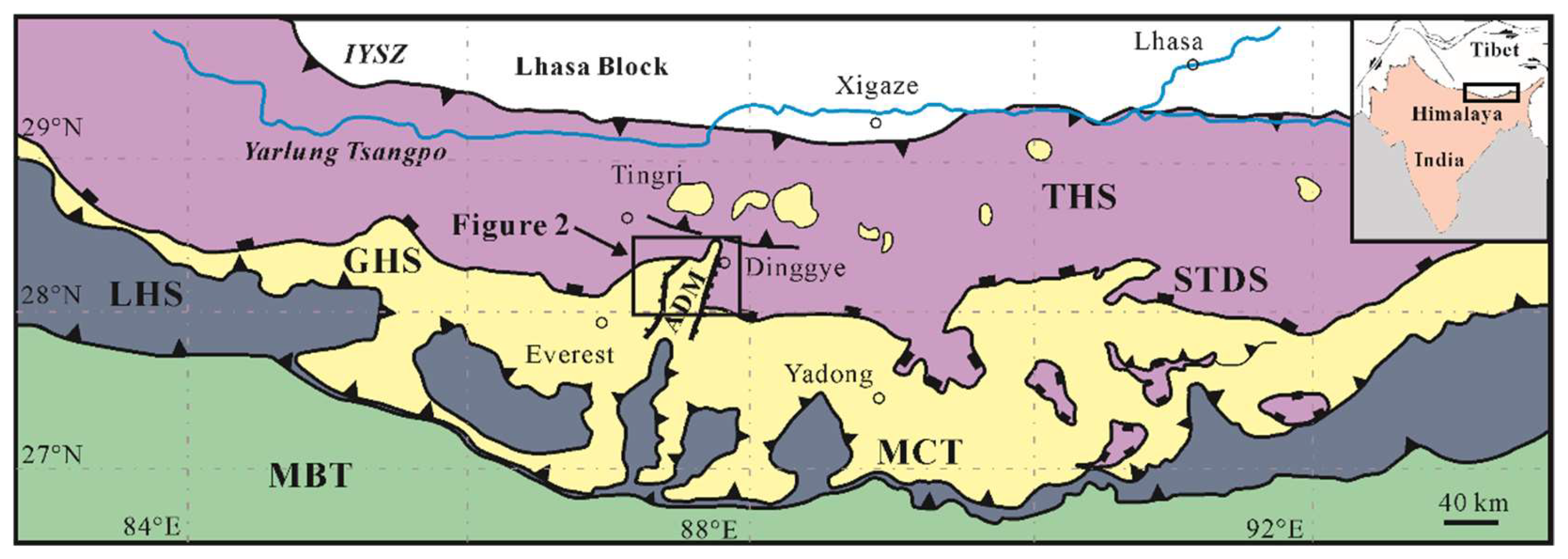
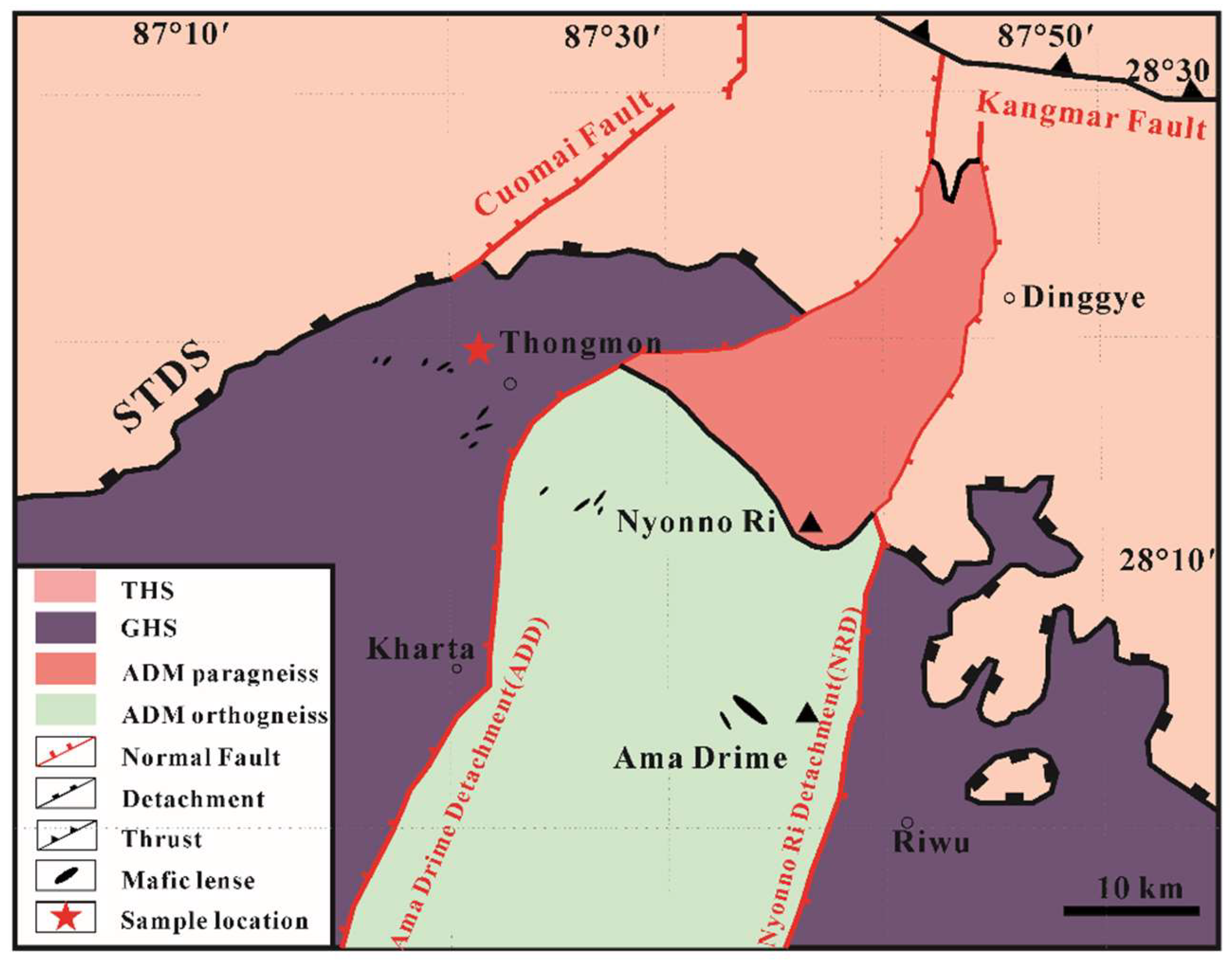
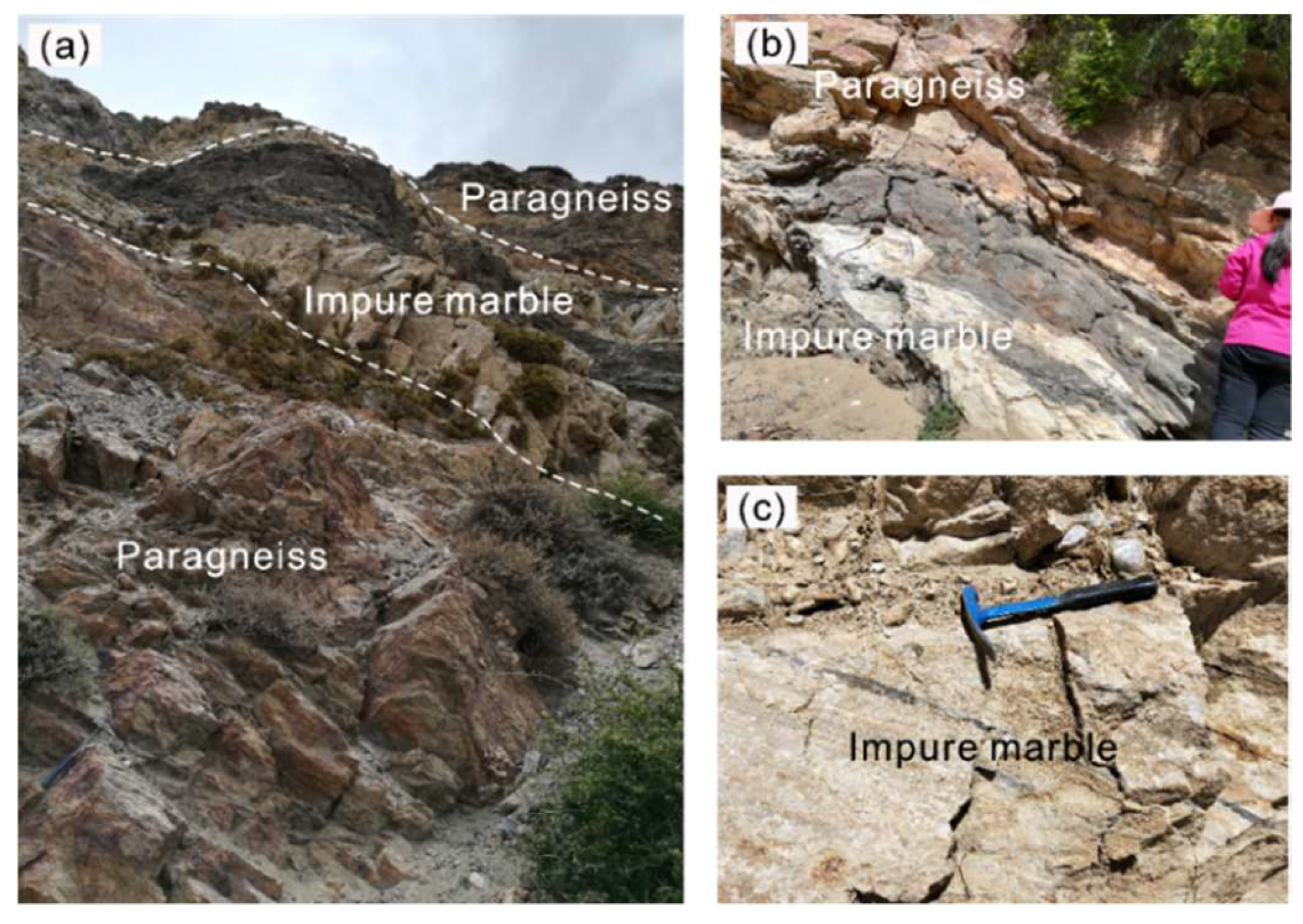

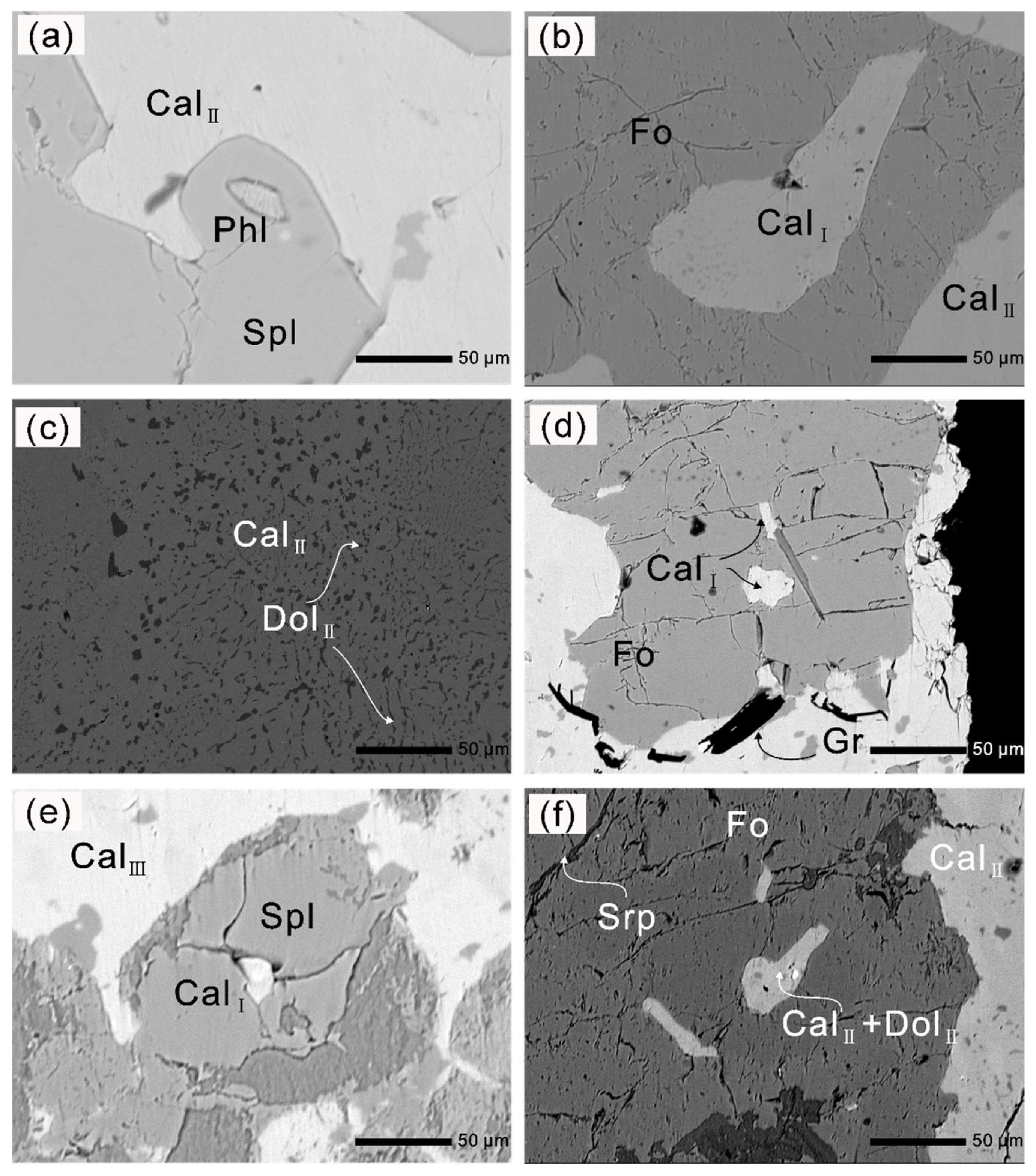

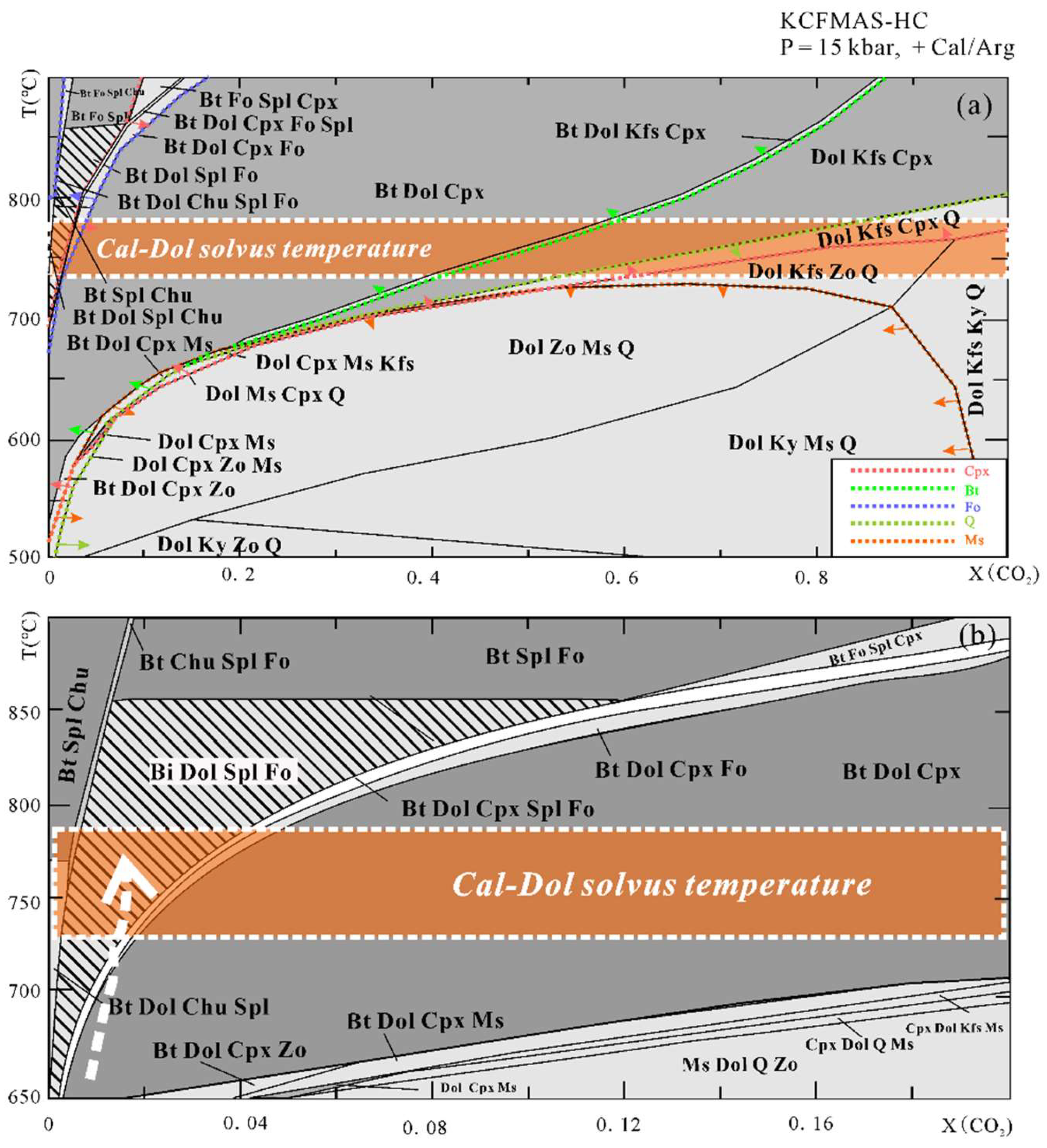

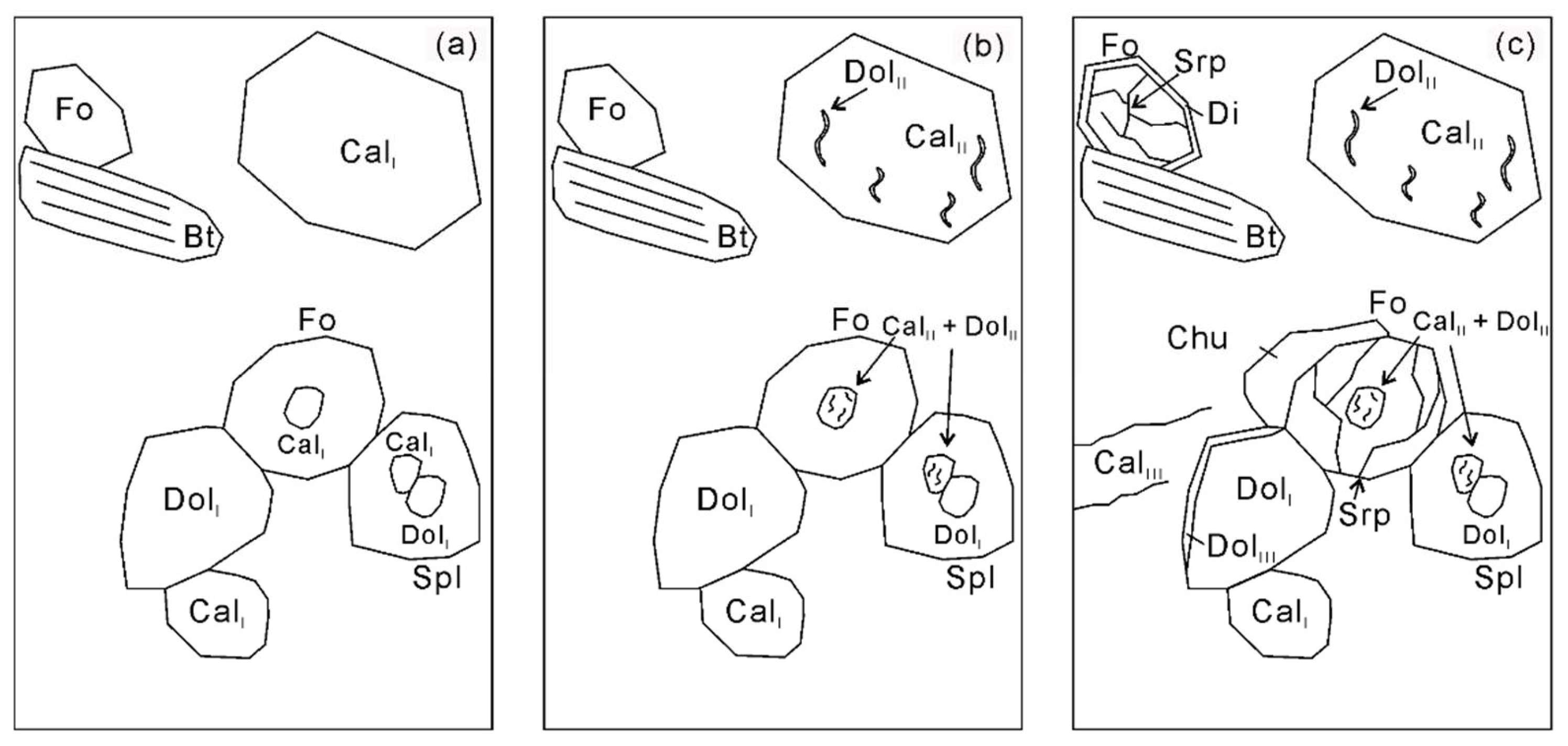
| Textural Position | CalI | CalI | ||||||||
|---|---|---|---|---|---|---|---|---|---|---|
| In Fo | In Fo | In Phl | In Fo | In Fo | In Spl | In Matrix | ||||
| CaO (wt%) | 50.39 | 50.71 | 52.23 | 50.86 | 50.91 | 54.35 | 53.90 | 62.60 | 44.20 | 52.69 |
| MgO | 5.98 | 5.55 | 4.87 | 5.79 | 5.12 | 7.06 | 4.16 | 5.22 | 3.70 | 4.32 |
| FeO | 0.07 | 0.03 | 0.11 | 0.04 | 0.12 | 0.14 | 0.03 | 0.18 | 0.10 | 0.09 |
| Total | 56.44 | 56.29 | 57.21 | 56.69 | 56.15 | 61.55 | 58.09 | 68.00 | 48.00 | 57.10 |
| Ca (a.p.f.u) | 1.71 | 1.73 | 1.77 | 1.72 | 1.75 | 1.69 | 1.80 | 1.79 | 1.79 | 1.79 |
| Mg | 0.28 | 0.26 | 0.23 | 0.27 | 0.25 | 0.31 | 0.19 | 0.21 | 0.21 | 0.20 |
| Fe | 0.00 | 0.00 | 0.00 | 0.00 | 0.00 | 0.00 | 0.00 | 0.00 | 0.00 | 0.00 |
| XMg 1 | 0.142 | 0.132 | 0.115 | 0.137 | 0.123 | 0.153 | 0.097 | 0.104 | 0.104 | 0.102 |
| T (°C) 2 | 760 | 742 | 707 | 750 | 724 | 781 | 667 | 683 | 684 | 680 |
| CalII | CalIII | |||||||||
| in matrix | in matrix | |||||||||
| CaO | 54.04 | 53.09 | 54.19 | 53.27 | 53.02 | 54.52 | 53.29 | 53.22 | 54.62 | 55.16 |
| MgO | 2.29 | 2.34 | 2.49 | 2.51 | 3.33 | 2.38 | 3.33 | 3.30 | 0.05 | 0.12 |
| FeO | 0.00 | 0.08 | 0.06 | 0.09 | 0.01 | 0.01 | 0.05 | 0.04 | 0.00 | 0.03 |
| Total | 56.33 | 55.51 | 56.74 | 55.87 | 56.36 | 56.91 | 56.67 | 56.56 | 54.67 | 55.31 |
| Ca | 1.89 | 1.88 | 1.88 | 1.87 | 1.84 | 1.88 | 1.84 | 1.84 | 2.00 | 1.99 |
| Mg | 0.11 | 0.12 | 0.12 | 0.12 | 0.16 | 0.11 | 0.16 | 0.16 | 0.00 | 0.01 |
| Fe | 0.00 | 0.00 | 0.00 | 0.00 | 0.00 | 0.00 | 0.00 | 0.00 | 0.00 | 0.00 |
| XMg | 0.056 | 0.058 | 0.060 | 0.062 | 0.080 | 0.057 | 0.080 | 0.079 | 0.002 | 0.003 |
| T(°C) | 548 | 556 | 564 | 569 | 625 | 554 | 625 | 622 | ||
| DolI | DolI | DolII | DolII | DolII | DolII | DolII | DolIII | DolIII | DolIII | |
| CaO | 32.05 | 32.38 | 35.11 | 35.28 | 35.47 | 32.98 | 32.46 | 37.26 | 37.79 | 42.56 |
| MgO | 21.54 | 21.30 | 20.30 | 20.69 | 21.71 | 20.54 | 20.17 | 20.98 | 18.87 | 15.06 |
| FeO | 0.17 | 0.22 | 0.22 | 0.18 | 0.22 | 0.19 | 0.19 | 0.17 | 0.18 | 0.12 |
| Total | 53.76 | 53.90 | 55.63 | 56.15 | 57.40 | 53.71 | 52.82 | 58.41 | 56.84 | 57.74 |
| Ca | 1.03 | 1.04 | 1.10 | 1.10 | 1.08 | 1.07 | 1.07 | 1.12 | 1.18 | 1.34 |
| Mg | 0.96 | 0.95 | 0.89 | 0.89 | 0.92 | 0.93 | 0.92 | 0.88 | 0.82 | 0.66 |
| Fe | 0.00 | 0.01 | 0.01 | 0.00 | 0.01 | 0.01 | 0.01 | 0.00 | 0.00 | 0.00 |
| XMg | 0.48 | 0.48 | 0.45 | 0.45 | 0.46 | 0.46 | 0.46 | 0.44 | 0.41 | 0.33 |
| Fo | Fo | Fo | Chu | Chu | Chu | Phl | Phl | Phl | Spl | Spl | |
|---|---|---|---|---|---|---|---|---|---|---|---|
| SiO2 (wt%) | 41.06 | 41.97 | 41.82 | 39.02 | 39.08 | 39.07 | 42.83 | 40.52 | 40.46 | 0.01 | 0.02 |
| TiO2 | 0.00 | 0.00 | 0.00 | 0.64 | 0.48 | 0.53 | 0.57 | 0.07 | 0.57 | 0.00 | 0.03 |
| Al2O3 | 0.02 | 0.03 | 0.02 | 0.02 | 0.00 | 0.02 | 13.57 | 15.9 | 14.62 | 69.89 | 70.33 |
| FeO | 1.40 | 1.50 | 1.42 | 0.97 | 1.00 | 0.86 | 0.29 | 0.32 | 0.26 | 1.30 | 1.34 |
| MnO | 0.00 | 0.01 | 0.06 | 0.06 | 0.04 | 0.07 | 0.04 | 0.02 | 0.01 | 0.00 | 0.06 |
| MgO | 57.55 | 56.78 | 55.93 | 58.08 | 58.65 | 57.88 | 27.58 | 26.74 | 25.82 | 25.87 | 26.37 |
| CaO | 0.08 | 0.03 | 0.00 | 0.02 | 0.02 | 0.05 | 0.54 | 0.02 | 0.18 | 0.19 | 0.04 |
| Na2O | 0.00 | 0.00 | 0.02 | 0.00 | 0.00 | 0.00 | 0.42 | 0.26 | 0.19 | 0.00 | 0.00 |
| K2O | 0.02 | 0.00 | 0.00 | 0.01 | 0.01 | 0.00 | 9.3 | 9.63 | 10.13 | 0.04 | 0.00 |
| F | 0.00 | 0.00 | 0.00 | 2.21 | 2.29 | 2.40 | 0.74 | 0.87 | 2.21 | 0.07 | 0.06 |
| F=O | 0.00 | 0.00 | 0.00 | −0.93 | −0.99 | −1.01 | −0.31 | −0.37 | −0.93 | −0.03 | −0.03 |
| Total | 100.23 | 100.29 | 99.27 | 100.09 | 99.59 | 99.87 | 95.57 | 94.02 | 93.52 | 97.34 | 98.22 |
| Si (a.p.f.u) | 1.00 | 1.00 | 1.00 | 3.98 | 3.97 | 3.99 | 2.97 | 2.86 | 2.91 | 0.00 | 0.00 |
| Ti | 0.00 | 0.00 | 0.00 | 0.05 | 0.04 | 0.04 | 0.03 | 0.00 | 0.03 | 0.00 | 0.00 |
| Al | 0.00 | 0.00 | 0.00 | 0.00 | 0.00 | 0.00 | 1.11 | 1.32 | 1.24 | 2.02 | 2.01 |
| Fe2+ | 0.02 | 0.03 | 0.03 | 0.08 | 0.09 | 0.07 | 0.01 | 0.02 | 0.01 | 0.03 | 0.03 |
| Mn | 0.00 | 0.00 | 0.00 | 0.00 | 0.00 | 0.00 | 0.00 | 0.00 | 0.00 | 0.00 | 0.00 |
| Mg | 1.97 | 1.98 | 1.96 | 8.84 | 8.89 | 8.83 | 2.85 | 2.81 | 2.76 | 0.94 | 0.95 |
| Ca | 0.00 | 0.00 | 0.00 | 0.01 | 0.00 | 0.01 | 0.04 | 0.03 | 0.01 | 0.01 | 0.00 |
| Na | 0.00 | 0.00 | 0.00 | 0.01 | 0.00 | 0.00 | 0.06 | 0.04 | 0.03 | 0.00 | 0.00 |
| K | 0.00 | 0.00 | 0.00 | 0.01 | 0.00 | 0.00 | 0.82 | 0.87 | 0.93 | 0.00 | 0.00 |
| Sum 1 | 2.99 | 3.01 | 2.99 | 12.97 | 12.99 | 12.96 | 7.9 | 7.93 | 7.92 | 2.99 | 2.99 |
| F | 0.00 | 0.00 | 0.00 | 0.71 | 0.74 | 0.78 | 0.16 | 0.19 | 0.5 | 0.01 | 0.01 |
| XMg 2 | 0.99 | 0.99 | 0.99 | 0.99 | 0.99 | 0.99 | 1.00 | 0.99 | 0.995 | 0.97 | 0.97 |
Publisher’s Note: MDPI stays neutral with regard to jurisdictional claims in published maps and institutional affiliations. |
© 2022 by the authors. Licensee MDPI, Basel, Switzerland. This article is an open access article distributed under the terms and conditions of the Creative Commons Attribution (CC BY) license (https://creativecommons.org/licenses/by/4.0/).
Share and Cite
Chen, X.; Zhang, L.; Zhang, G.; Lü, Z. The Calcite-Dolomite Solvus Temperature and T-X(CO2) Evolution in High-Grade Impure Marble from Thongmön Area, Central Himalaya: Implications for Carbon Cycling in Orogenic Belts. Minerals 2022, 12, 724. https://doi.org/10.3390/min12060724
Chen X, Zhang L, Zhang G, Lü Z. The Calcite-Dolomite Solvus Temperature and T-X(CO2) Evolution in High-Grade Impure Marble from Thongmön Area, Central Himalaya: Implications for Carbon Cycling in Orogenic Belts. Minerals. 2022; 12(6):724. https://doi.org/10.3390/min12060724
Chicago/Turabian StyleChen, Xueqian, Lifei Zhang, Guibin Zhang, and Zeng Lü. 2022. "The Calcite-Dolomite Solvus Temperature and T-X(CO2) Evolution in High-Grade Impure Marble from Thongmön Area, Central Himalaya: Implications for Carbon Cycling in Orogenic Belts" Minerals 12, no. 6: 724. https://doi.org/10.3390/min12060724
APA StyleChen, X., Zhang, L., Zhang, G., & Lü, Z. (2022). The Calcite-Dolomite Solvus Temperature and T-X(CO2) Evolution in High-Grade Impure Marble from Thongmön Area, Central Himalaya: Implications for Carbon Cycling in Orogenic Belts. Minerals, 12(6), 724. https://doi.org/10.3390/min12060724





